DeWalt DS350 Handleiding
DeWalt
Niet gecategoriseerd
DS350
Bekijk gratis de handleiding van DeWalt DS350 (6 pagina’s), behorend tot de categorie Niet gecategoriseerd. Deze gids werd als nuttig beoordeeld door 269 mensen en kreeg gemiddeld 4.6 sterren uit 135 reviews. Heb je een vraag over DeWalt DS350 of wil je andere gebruikers van dit product iets vragen? Stel een vraag
Pagina 1/6

1
DS350 CONTAINER SENSOR
WARNING: Read and understand all instructions and warnings for this product.
In addition, read and follow all instructions and warnings provided with the DS100
Jobsite Security Portable Alarm System.
CAUTION: DANGER OF EXPLOSION, INJURY, OR FIRE. Carefully follow all instructions
and warnings on the battery label and package.
• Never use a damaged or worn out battery.
• Discharged batteries should be replaced only with type CR-123 3.0 Volt Lithium batteries.
• Do not use re-chargeable batteries or attempt to charge batteries.
• Carefully remove the old, discharged battery.
• Do not attempt to open.
• Do not peel the label from the battery.
• Never dispose of a battery in a fire.
• Dispose of used batteries in accordance with local regulations.
• Recycle batteries.
• Always insert batteries correctly with regard to polarity (+ and -) marked on the battery and
the equipment.
• When installing the battery, do not use excessive force. If the battery does not fit, check to
make sure that it matches the polarity markings.
• Never expose the battery terminals to any other metal object. This can short circuit the
battery.
• Avoid exposure to temperature extremes.
• When not in use, store the battery in a cool, dark, dry place.
• Keep batteries out of reach of children.
• This product is designed for indoor/outdoor use.
FCC REGULATORY STATEMENT (FCC: HCQ3B6ETVCSM)
• This device complies with Part 15 of the FCC rules. Operation is subject to the following
two conditions: (1) This device may not cause harmful interference, and (2) the device
must accept any interference received, including interference that may cause undesired
operation.
INDUSTRY CANADA (IC: 2309A-ETVCSM)
•NOTICE: This equipment meets the applicable Industry Canada Terminal Equipment
Technical Specifications. This is confirmed by the registration number. The abbreviation,
IC, before the registration number signifies that registration was performed based on a
Declaration of Conformity indicating that Industry Canada technical specifications were
met. It does not imply that Industry Canada approved the equipment.
Components (Fig. 1–3)
A. Sounder E. Battery
B. Tampers F. Captive screw
C. Reset button G. Mounting holes
D. Sensitivity adjustment
Product Function
The DS350 Container Sensor is used for monitoring remote metal containers by measuring
vibration.
Once activated, this device will work exclusively with the assigned DS100 Jobsite Security
Portable Alarm System.
NOTE: Metal objects blocking radio frequency (RF) transmission can affect the range of the
sensor.
Prevention of False Alarms
The majority of alarms that occur are false. These situations happen every day due to user
error, incorrect installation or improper maintenance of the system. False alarms will limit the
responsiveness to the system, and become a general inconvenience. As the number of false
alarms increases, authorities have become less apt to respond to alarm systems due to this
problem. Many of these situations can be avoided by following some very simple practices.
• Ensure all users are properly trained on the operation of the system.
• Always turn off the system with the Key Chain Remote Control before entering protected
area.
• Lock all protected doors, windows or any other asset attached to a sensor.
• Place the container sensor in area of minimal vibration.
• Check that premises are cleared and assets secured before setting the system.
• Turn off all noise sources – radios, compressors, generators, heavy equipment, etc.
• Know how to cancel an alarm or turn off the system before activating.
• If a false alarm is tripped notify customer service immediately.
• Test the system on a monthly basis to ensure proper functioning.
• Check cellular signal, power supply, and that sensors are secured on a daily basis.
SETUP
Installing & Changing Battery
The DS350 Container Sensor requires a non-rechargeable CR-123 3.0 Volt Lithium battery.
NOTE: The system must be disarmed prior to any programming changes.
TO INSTALL A BATTERY
1. Using a Phillips screwdriver, loosen the captive screw (F).
2. Flip open the latch.
3. Install the battery using the polarity (+ and -) markings on the battery and equipment.
Do not use excessive force. If the battery does not fit, ensure that it matches the polar-
ity markings.
NOTE: When changing the battery the reset button (C) must be pressed.
4. After registering or resetting the sensor (see ), replace the cover.Device Registration
By opening the device, the Base Unit may display a tamper fault.
TO CLEAR A FAULT
a. Select DISPLAY.
b. Scroll list of fault(s).
c. Select CLEAR.
d. Enter master code.
e. Select OK.
CAUTION: When changing the battery, never use a damaged or worn out battery.
Device Registration
To activate the device, it must first be assigned to your DS100 Base Unit. Refer to the DS100
Jobsite Security Portable Alarm System Instruction Manual for more details on registering a
device during the initial setup.
NOTE: The system must be disarmed prior to any programming changes.
1. Press the MAIN MENU button on the keypad of the DS100 Base Unit.
2. Using the keypad, enter the master code.
3. Use the up and down arrows to scroll through the menu until the System Settings menu
is displayed. Select OK.
4. Use the up and down arrows to scroll through the menu until the Wireless Device
Maintenance menu is displayed. Select OK.
5. Use the up and down arrows to scroll through the menu until the Add/Replace Device
screen is displayed. Select OK.
6. The next available device number will be displayed. Up to 48 sensors can be registered
to the system. If there are no slots available, the screen will display ALL DEVICES IN
USE. When the device number is shown, select OK.
7. Using a Phillips screwdriver, remove the captive screw. Flip open the latch.
8. When prompted by the system’s LCD screen to RESET DEVICE, press and release the
reset button (C) located on the device’s sensitivity keypad (Fig. 2). The screen will indi-
cate that the device has been registered.
9. Immediately replace the cover.
10. To edit the description of the device, select EDIT.
11. To edit the description, use the keypad to type a description of up to 8 characters. The
character that is being changed will be underlined. To move back a character, use the
down arrow key. To move forward a character, use the up arrow key. When complete,
select SAVE.
IMPORTANT: Write the device description and corresponding device number on the
Sensor Location List included with the DS100 Jobsite Security Portable Alarm System.
Keep this sheet for reference. This information will be needed during the monitoring
service enrollment process. As device changes are made, be sure to contact DEWALT
customer service to make adjustments to the monitoring service.
12. After registration, test the sensor. If programming through the initial setup, the test function
will be included in the setup sequence. If adding the Container Sensor after the alarm
system has been programmed, use the TEST button on the keypad.
Recommended Locations
• Recommended for use on steel containers, large tool boxes, and tool storage boxes.
• Place on the
OUTSIDE
of a metal container to ensure transmission of RF signal.
• Place the DS350 Container Sensor near the lock and away from corners or reinforcement
ribs and brackets.
• A weak signal message will indicate that the sensor is within range but communication is
weak. A no check in message will indicate that the sensor is out of range.
Mounting
IMPORTANT: Because the Container Sensor uses radio frequency (RF) which can be
blocked by metal objects, place the DS350 Container Sensor
OUTSIDE
the container or
storage box.
NOTE: Metal objects blocking radio frequency (RF) transmission can affect the range of the
sensor.
USING MAGNETS
There are three magnets on the back of the container sensor to temporarily attach the sen-
sor on a container or storage box. If it is removed by an intruder while the system is disarmed,
the tamper switch will send a signal to the Base Unit. In the event that the system is armed,
an alarm will occur which in turn will notify the user.
USING BOLTS
In order to permanently attach the sensor on a container or storage box, use four #8 screws
or four bolts (not included) as appropriate for the material to which it is affixed.
1. Use the magnets to hold the DS350 in the desired location.
2. Pre-drill the four locations (G) as marked in Figure 3.
3. Place bolts through each hole.
4. Lock bolts with the appropriate nut (washer if desired).
IMPORTANT: To eliminate false alarms, be sure that the sensor is secure so it will not
be removed.
Adjust Sensitivity
Please refer to page 2 for Guide to Adjusting Sensitivity.
Tamper – Faults
Faults indicate when there has been a serious issue that needs to be addressed. This could
be a number of things including an unsecured device, low battery, tamper or weak signal.
If a fault is present, the Fault screen will be displayed. To bypass the Fault screen, select
SILENCE. To display the fault and resolve immediately, select DISPLAY. Use the up and
down arrows to scroll through the faults. Resolve the issue with the action listed in
Description of Fault Codes chart.
A
B
FIG. 1 FIG. 2
SITELOCK LLC, 701 East Joppa Road, Baltimore, MD 21286 (APR05) Form No. 626137-00 DS350 Copyright © 2004, 2005 DEWALT
CAUTION: POTENTIAL EQUIPMENT
MALFUNCTION OR FAILURE. Metal
objects blocking radio frequency (RF)
transmission can affect the range of the
sensor. Place Container Sensor on the
OUTSIDE of a metal container to ensure
transmission of RF signal. To ensure
communication with the Base Unit, use
Walk Test to test range.
CAUTION: POTENTIAL BATTERY AND
EQUIPMENT MALFUNCTION OR FAILURE.
Always insert batteries correctly with regard to
polarity (+ and -) marked on the battery and
the equipment.
E
C
D
F
B
FIG. 3 G
G
SUGGESTED LOCATION

2
TO REMOVE A TAMPER FAULT
1. Select CLEAR.
2. Use the keypad to enter the master code.
3. Select OK.
Fault Code Fault Display Description Action
DevPower Primary Power No battery power Change battery,
Lost Device # in device reset
DevLowBatt Low Battery Device battery Change battery,
Device # low reset
WeakSig Weak Signal Transmission signal Check for interference;
Device # from device is weak move device
Unsecured Unsecured Device has Check for intrusion;
Device # been tripped re-secure device
NoCheckIn No Check In Device check-in Check for interference;
Device # messages have move device
not been received
Tamper Tamper Device has been Close device or
opened or damaged replace if damaged
DESCRIPTION OF FAULT CODES
Full One Year Warranty
The DEWALT Jobsite Security Portable Alarm System is warranted for one year from date of
purchase. We will repair, without charge, any defects due to faulty materials or workmanship.
For warranty repair information, visit www.dewalt.com or call 1-800-4-DEWALT
(1-800-433-9258). This warranty does not apply to accessories or damage caused where
repairs have been made or attempted by others. This warranty gives you specific legal rights
and you may have other rights which vary in certain states or provinces.
The sounder in the container sensor has two functions: tone and beep.
Tone: When a battery is installed and the container sensor door is
opened and/or the sensor is not mounted, the device is in
Test Mode. This creates a long audible tone when vibration
is sensed. To test on a container, mount the device, then
listen for the tone as vibration is created. If the false alarm
filter* is in place, multiple vibrations may be required to
create the tone.
Quick Beep: The sounder will indicate a beeping noise as the
sensitivity is increased (less vibration is required) or
decreased (stronger and multiple vibrations are required).
When the maximum and minimum are reached the sensor
will beep three times. Refer to the Sensitivity Chart below
for descriptions.
* False Alarm Filter assists in blocking out false alarms associated with thunder claps, accidental bumping, objects
falling on the container, etc., by requiring multiple or continuous vibrations as typical with drilling out a lock or
directly cutting the container.
VIBRATION TESTING (SENSITIVITY SETTINGS)
Use the up and down arrows (D) to adjust the sensitivity as appropriate for the type of container being secured.
There are 8 sensitivity settings. The Container Sensor is preset at setting 4 when shipped. See the Sensitivity
Chart for a description of each setting. Create vibrations on the container. If the false alarm filter is in place, multiple
vibrations may be required to create the tone. Decrease sensitivity if false alarms continually occur.
WALK TEST (COMMUNICATION TO BASE UNIT)
Read the DS100 instruction manual for step-by-step walk test instructions. To activate the Container Sensor
walk test, create vibration on the container with the sensor door closed. If the false alarm filter is in place, multiple
vibrations may be required to complete the test. The Base Unit will indicate that the test was successful when
the device is removed from the list on the LCD screen.
HOW IT WORKS
When the Container Sensor door is closed and the sensor is mounted:
1. The sensor alerts the base unit that vibration has occurred (no tone will sound). If the Base Unit is armed, an
alarm signal will be sent.
2. The sensor will enter sleep mode for 3 minutes after it senses vibration. The sleep mode was designed to
conserve battery life. This 3-minute delay will restart each time a vibration is sensed.
NOTE: No tone will sound if the container sensor door is opened during the 3 minutes.
3. To “wake up” the sensor, press the RESET button.
increased
sensitivity
decreased
sensitivity
Guide to Adjusting Sensitivity
SENSITIVITY CHART
(3 beeps
Vibrations False Alarm Application
at the end)
Filter*
Quiet Area Indoors; want to be notified if
8• Single vibration the door of the container is opened
or the container is moved
Quiet Area Indoors; want to be notified if
7• Single vibration the door of the container is opened
or the container is moved
• Requires multiple Area prone to false alarms (outdoors);
6vibrations over a x concerned about someone tampering with
short period of time the lock or attempting to cut into the container
• Requires multiple Area prone to false alarms (outdoors);
5vibrations over a x concerned about someone tampering with the
short period of time lock or attempting to cut into the container
• Requires multiple Area prone to false alarms (outdoors);
4vibrations over a x concerned about someone tampering with
short period of time the lock or attempting to cut into the container
• Requires multiple Area prone to false alarms (outdoors, containers
3vibrations over a x may be moved, etc.); concerned about someone
short period of time drilling out the lock or cutting the container
• Requires continuous Area very prone to false alarms (high activity
2vibrations over a x and noise area); concerned about someone
short period of time drilling out the lock or cutting the container
1• Requires continuous Area very prone to false alarms (high activity
vibrations over a x and noise area); concerned about someone
(3 beeps
short period of timex drilling out the lock or cutting the container
at the end)
Applications and placements are suggestions only. DEWALT does not guarantee the prevention of theft and
vandalism even when these guidelines are followed.
* False Alarm Filter assists in blocking out false alarms associated with thunder claps, accidental bumping,
objects falling on the container, etc.
IMPORTANT NOTE: When testing sensitivity, test for both the strength of the vibration and the number of times
the vibration occurs. The false alarm filter may require several vibrations to trip the sensor.
most
sensitive
least
sensitive

3
DÉTECTEUR DE CAISSON DS350
AVERTISSEMENT : Lire et comprendre tout avertissement et toute instruction
inclus dans ce manuel. De plus, lire tout avertissement et toute instruction fournis avec
le Système d’alarme mobile de sécurité des chantiers DS100.
MISE EN GARDE : RISQUES D’EXPLOSION, DE BLESSURE OU D’INCENDIE.
Suivre attentivement toute instruction ou tout avertissement inclus sur l’étiquette ou l’em-
ballage des piles.
• Ne jamais utiliser une pile endommagée ou usée.
• Les piles déchargées doivent être remplacées par des piles au lithium de type CR-123
de 3,0 volts.
• Ne pas utiliser de piles rechargeables ou tenter de recharger les piles.
• Retirer soigneusement la vieille pile déchargée.
• Ne pas chercher à l’ouvrir.
• Ne pas retirer l’étiquette d’une pile.
• Ne jamais mettre une pile au feu.
• S’en défaire conformément aux régulations locales.
• Recycler les piles.
• Lors de l’installation des piles, toujours respecter la polarité (+ et -) inscrite sur les piles et
l’appareil.
• Pour installer une pile, ne pas forcer excessivement. Si la pile ne rentre pas, vérifier que
la polarité des bornes cadre avec les marques sur l’appareil.
• Ne jamais mettre les bornes des piles en contact avec tout autre objet métallique. Cela
pourrait provoquer un court circuit.
• Éviter de les exposer à des températures extrêmes.
• Après utilisation, entreposer les piles dans un lieu frais, sombre et sec.
• Conserver les piles hors de la portée des enfants.
COMMUNIQUÉ DE LA FEDERAL COMMUNICATIONS
COMMISSION (FCC: HCQ3B6ETVCSM)
• Ce dispositif est conforme aux dispositions du paragraphe 15 des règlements de la FCC.
Son utilisation est sujette aux deux conditions suivantes : (1) Ce dispositif ne doit pas
causer d’interférences nuisibles, et (2) ce dispositif doit accepter toute interférence reçue,
y compris toute interférence pouvant causer un fonctionnement indésirable.
INDUSTRIE CANADA (IC: 2309A-ETVCSM)
•REMARQUE : Cet équipement se conforme aux Spécifications Techniques pour
Équipement Terminal d’Industrie Canada. Le numéro d’enregistrement le confirme.
L’abréviation « IC » devant le numéro d’enregistrement signifie que l’enregistrement est
basé sur une Déclaration de Conformité indiquant que les spécifications techniques
d’Industrie Canada ont été respectées. Cela ne veut pas dire que cet équipement a été
approuvé par Industrie Canada.
Description (fig. 1–3)
A. Alarme E. Pile
B. Altération F. Vis imperdable
C. Bouton de réinitialisation G. Orifices d’installation
D. Réglage de sensibilité
Fonction du produit
Le détecteur de caisson DS350 permet de surveiller à distance des caissons métalliques en
mesurant les vibrations les affectant.
Une fois activé, ce dispositif ne fonctionnera qu’avec le Système d’alarme mobile de sécurité
des chantiers DS100.
REMARQUE : Tout objet métallique pouvant bloquer la transmission des radiofréquences
(RF) peut affecter la portée du détecteur.
Prévention des fausses alertes
La majorité des alertes sont fausses. Ces situations se répètent quotidiennement dues à
l’erreur humaine, une installation incorrecte ou un manque d’entretien du système. Les
fausses alertes limiteront le degré de réactivité du système, et deviendront une nui-
sance. Alors que le nombre de fausses alertes augmente, les autorités sont moins aptes
à répondre aux systèmes d’alarme à cause de ce problème. Bien de ces situations peu-
vent être évitées en suivant certaines procédures très simples.
• S’assurer que tous les utilisateurs ont été correctement formés pour utiliser le système.
• Toujours arrêter le système avec la télécommande porte-clés avant de pénétrer dans une
zone protégée.
• Verrouiller toute porte ou fenêtre protégée ou tout autre bien connecté à un détecteur.
• Installer le détecteur de caisson dans un lieu sujet à un minimum de vibration.
• Vérifier que les lieux sont vacants et les biens sécurisés avant d’activer le système.
• Éliminer toute source de bruit : radios, compresseurs, générateurs, machinerie lourde,
etc.
• Savoir comment annuler une alerte et arrêter le système avant d’activer ce dernier.
• En cas de fausse alerte, appeler le service clientèle immédiatement.
• Tester le système mensuellement pour assurer son bon fonctionnement.
• Vérifier quotidiennement le signal cellulaire, la source de courant et la sécurité des
détecteurs.
CONFIGURATION
Installation et remplacement de la pile
Le détecteur de caisson DS350 requiert une pile au lithium non rechargeable CR-123 de 3.0
volts.
REMARQUE : Le système doit être tout d’abord désarmé avant d’effectuer tout changement
de programmation.
POUR INSTALLER UNE PILE
1. À l’aide d’un tournevis Phillips, dévisser la vis imperdable (F).
2. Ouvrir le loquet.
3. Installer la pile en s’assurant de bien respecter la polarité (+ et -) indiquée sur la pile et
l’appareil. Ne pas forcer excessivement. Si la pile ne rentre pas, vérifier que la polarité
des bornes cadre avec les marques sur l’appareil.
REMARQUE : Une fois la pile installée, appuyer sur le bouton de réinitialisation (C).
4. Une fois l’enregistrement ou la réinitialisation du détecteur terminé (se reporter à la sec-
tion Enregistrement du dispositif), remettre le couvercle. À l’ouverture du dispositif. la
base affichera peut-être une erreur d’altération.
POUR ÉLIMINER UNE ERREUR
a. Choisir AFFICH.
b. Faire défiler la liste d’erreur(s).
c. Choisir EFFAC.
d. Entrer le code maître.
e. Choisir OK.
MISE EN GARDE : Au moment de changer la pile, ne jamais utiliser de pile endommagée
ou usée.
Enregistrement du dispositif
Pour activer le dispositif, il faut tout d’abord l’assigner à la base DS100. Se référer au manuel
d’instruction du Système d’alarme mobile de sécurité des chantiers DS100 pour plus de
détails relatifs à l’enregistrement pendant la configuration initiale d’un dispositif.
REMARQUE : Le système doit être tout d’abord désarmé avant d’effectuer tout changement
de programmation.
1. Appuyer sur le bouton MENU PRINCIPAL sur le clavier de la base DS100.
2. À l’aide du clavier, entrer le code maître.
3. Utiliser les flèches vers le haut ou le bas pour faire défiler le menu jusqu’à ce que l’écran
Options sys.
soit affiché. Choisir OK.
4. Utiliser les flèches vers le haut ou le bas pour faire défiler le menu jusqu’à ce que l’écran
Entr. disp. mobiles
soit affiché. Choisir OK.
5. Utiliser les flèches vers le haut ou le bas pour faire défiler le menu jusqu’à ce que l’écran
Aj/Remp dispositif
soit affiché. Choisir OK.
6. Le prochain numéro de dispositif libre sera affiché. Jusqu’à 48 détecteurs peuvent être
enregistrés au système. S’il ne reste aucun numéro disponible, l’écran affichera 0 DIS-
POSITIF DISP. Lorsque le numéro de dispositif est affiché, choisir OK.
7. À l’aide d’un tournevis Phillips, retirer la vis imperdable (F). Ouvrir le loquet.
8. À la demande « REINIT DISP » du système sur l’écran ACL, appuyer puis relâcher le bou-
ton de réinitialisation (C) situé sur le clavier de sensibilité du dispositif (Fig. 2). L’écran indi-
quera que le dispositif a bien été enregistré.
9. Remettre immédiatement le couvercle.
10. Pour modifier la description du dispositif, choisir EDIT.
11. Pour modifier la description, à l’aide du clavier, taper une description jusqu’à 8 caractères.
Le caractère qui sera changé sera souligné. Pour reculer d’un caractère, utiliser la flèche
vers le bas. Pour avancer d’un caractère, utiliser la flèche vers le haut. Une fois terminé,
choisir ENREG.
IMPORTANT : Inscrire la description du dispositif et son numéro correspondant sur la Liste
d’emplacements des détecteurs incluse avec le Système d’alarme mobile de sécurité des
chantiers DS100. Conserver cette liste à titre de référence. Cette information sera néces-
saire pendant le processus d’enregistrement au service de surveillance. Chaque fois qu’un
dispositif est modifié, s’assurer de bien contacter le service clientèle DEWALT pour rapporter
toute modification au service de surveillance.
12. Après l’enregistrement, tester le détecteur. Au cours de la configuration initiale, la fonction
Test fait partie automatiquement de la programmation. Si le détecteur de caisson est
ajouté après la programmation initiale du système, utiliser le bouton Test sur le clavier.
Recommandations d’utilisation
• Le dispositif est recommandé pour être utilisé sur des conteneurs acier, de larges boîtes
ou caissons à outils.
• Installer le dispositif sur
l’EXTÉRIEUR
du caisson métallique pour assurer la transmission
continue du générateur de signaux RF.
• Installer le détecteur de caisson DS350 près du verrou et loin des coins ou de tout ren-
fort ou support.
• Un signal faible indique que le détecteur est à portée de réception mais que la communi-
cation est faible. Le message « NON VALIDÉ » indique que le détecteur est hors de
portée.
Installation murale
IMPORTANT : Comme le détecteur de caisson utilise une transmission de radiofréquences
(RF) pouvant être affectées par des objets métalliques, installer le détecteur de caisson
DS350 à
l’EXTÉRIEUR
du caisson ou de la boîte de stockage.
REMARQUE : Tout objet métallique pouvant bloquer la transmission des radiofréquences
(RF) peut affecter la portée du détecteur.
UTILISATION DES AIMANTS
Il existe trois aimants à l’arrière du détecteur de caisson pour rattacher temporairement ce
dernier à un caisson ou une boîte de stockage. Si le détecteur est retiré par un intrus alors
que le système est désarmé, l’interrupteur d’altération enverra une alerte à la base. Si le sys-
tème est armé, une alerte sera déclenchée et l’utilisateur sera averti.
UTILISATION DES BOULONS
Pour installer le détecteur sur le caisson ou la boîte de stockage de façon permanente, utilis-
er quatre vis n°8 ou quatre boulons (non compris) suivant le matériau sur lequel il sera fixé.
1. Utiliser les aimants pour maintenir le DS350 à l’endroit désiré.
2. Pré percer les quatre emplacements (G) comme illustré en Figure 3.
3. Mettre un boulon dans chaque trou.
4. Visser les boulons avec l’écrou approprié (et une rondelle si nécessaire).
IMPORTANT : Pour éliminer toute fausse alerte, s’assurer que le détecteur est bien arrimé
pour éviter qu’il soit retiré.
Réglage de la sensibilité
Se reporter au Guide de réglage de la sensibilité en page 4 pour plus d’informations.
Altération–Erreurs
Les erreurs indiquent qu’un problème sérieux doit être adressé. Cela peut représenter
plusieurs choses y compris un dispositif suspect, une pile faible, un dispositif altéré ou un sig-
nal faible.
En cas d’erreur, l’écran d’erreur sera affiché. Pour contourner un écran d’erreur, choisir
SILENCE. Pour afficher l’erreur et la résoudre immédiatement, choisir AFFICH. Utiliser les
flèches vers le haut ou le bas pour faire défiler les erreurs. Résoudre le problème en suivant
les actions à prendre dans le tableau Description des codes d’erreurs.
MISE EN GARDE : RISQUES DE MAUVAIS
FONCTIONNEMENT OU DE DÉFAILLANCE.
Tout objet métallique pouvant bloquer la trans-
mission des radiofréquences (RF) peut affecter la
portée du détecteur. Installer le détecteur de cais-
son sur l’ du caisson métalliqueEXTÉRIEUR
pour assurer la transmission continue des
signaux RF. Pour vérifier la fiabilité de la commu-
nication avec la base, effectuer un test de
marche pour tester la portée.
MISE EN GARDE : RISQUES DE
MAUVAIS FONCTIONNEMENT OU
DE DÉFAILLANCE AU NIVEAU DES
PILES OU DU MATÉRIEL. Lors
de l’installation des piles, toujours
respecter la polarité (+ et -) inscrite sur
les piles et l’appareil.
F
FIG. 3 G
G
EMPLACEMENT SUGGÉRÉ
A
B
FIG. 1 FIG. 2
E
C
DB
Product specificaties
| Merk: | DeWalt |
| Categorie: | Niet gecategoriseerd |
| Model: | DS350 |
Heb je hulp nodig?
Als je hulp nodig hebt met DeWalt DS350 stel dan hieronder een vraag en andere gebruikers zullen je antwoorden
Handleiding Niet gecategoriseerd DeWalt
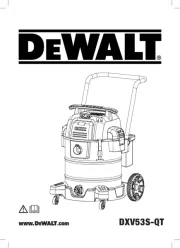
27 Augustus 2025
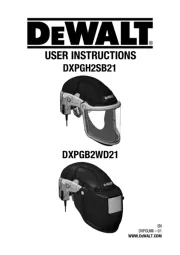
26 Augustus 2025

26 Augustus 2025

26 Augustus 2025

26 Augustus 2025
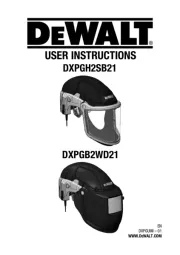
25 Augustus 2025
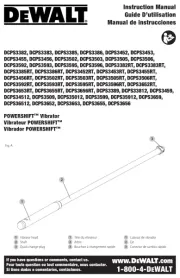
3 Augustus 2025
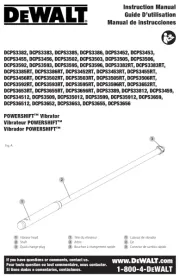
3 Augustus 2025
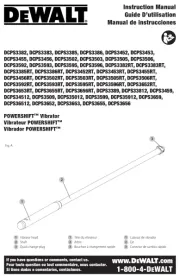
3 Augustus 2025
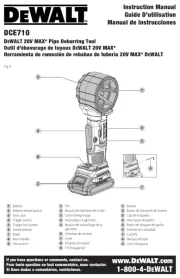
29 Juli 2025
Handleiding Niet gecategoriseerd
- Husqvarna
- Playseat
- Phoenix Gold
- Colonial Elegance
- Jata
- Glorious
- Victron Energy
- Sekonic
- AVM
- BEA
- Nodor
- Axagon
- Avidsen
- Grimm Audio
- Laser
Nieuwste handleidingen voor Niet gecategoriseerd

14 September 2025

14 September 2025

13 September 2025

13 September 2025

13 September 2025

13 September 2025

13 September 2025

13 September 2025

13 September 2025

13 September 2025